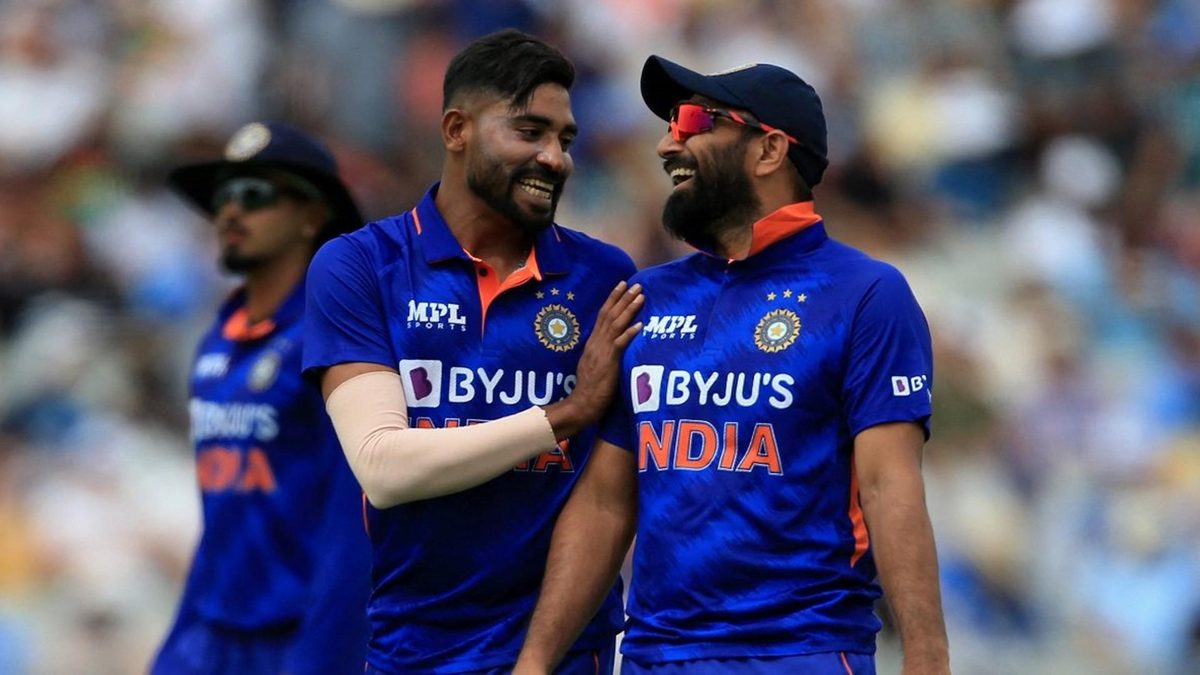
Jasprit Bumrah’s injuries have left a question mark over his availability on a regular basis. Yet, India need not be overly worried, for Mohammed Shami, Mohammed Siraj, and their ilk have stepped up, writes Abhishek Mukherjee.
Eight overs into the second ODI, India had conceded six singles, three wides, and a leg-bye to New Zealand. In all, six of the 48 legal deliveries – fewer than a ball an over – had seen a run notched against the bowler. Mohammed Shami (4-1-5-2) and Mohammed Siraj (4-1-4-1) had taken out three wickets by then.
This was not in windy Wellington where new-ball bowlers seem to beat the bat every time they do not take a wicket. This was in Raipur, India’s newest venue where Yastika Bhatia had slammed an unbeaten 61-ball 99 in a T20 match not too long ago.
New Zealand fought back after being 15-5, but were still bundled out for 108. Shami finished with 3-18 and Siraj 1-10. Their fellow seamers, Hardik Pandya (2-16) and Shardul Thakur (1-26) accounted for three more wickets. India won at a canter.
New Zealand’s collapse took place six days after India had bowled out Sri Lanka for 73. On that occasion, Shami had taken 2-20 and Siraj 4-32.
Of course, one may argue that Sri Lanka had crumbled under ‘scoreboard pressure’ – a target of 391 can do that. One may even credit India’s spinners for bowling South Africa out for 99 in Kotla in October. But at The Oval in July, Jasprit Bumrah (6-19) and Shami (3-31) reduced England to 26-5 before they somehow reached 110.
Since the start of 2022, India have played 29 ODIs – eight more than any other side in the world. Their stars had stayed away from many of these. Some of these absences were due to injuries. Others can be attributed to them being rested for Test cricket and the T20 World Cup.
Shikhar Dhawan, who has featured in 22, does not play in the other formats. Shreyas Iyer and Siraj, the only others to have played in 20, were standbys at the World Cup.
What these experimental – it does not seem fair to call a team that has won 19 matches and lost eight ‘second-string’ – XIs have done is help India to build a cohort of fringe cricketers with experience at the top level.
Jasprit Bumrah (108 wickets at 25.33) and Shami (148 at 25.62) stand out among India’s pace options. Shami’s strike rate of 27.5 means that he takes more than two wickets every 10 overs. Bumrah boasts of an economy rate of 4.65.
Seldom have two fast bowlers of such quality assembled in an ODI unit. There was little doubt that both would play key roles in the 2023 World Cup on Indian soil. Yet, since the start of 2022, Bumrah has featured in five of India’s 29 ODIs and Shami in eight – and both of them in only two.
Yet, none of that has prevented the Indian pace attack from wreaking havoc. In his only ODI before 2022, back in 2018/19, Siraj had gone for 10-0-76-0 against Australia. Since last year, he has emerged as the temporary spearhead of the Indian attack, taking 38 wickets (more than anyone from a team that will feature at the World Cup) at 18.73 apiece.
Siraj is not the only one. Thakur, slower than Siraj, had taken only 22 wickets from 15 ODIs until 2021. He has taken 25 in 18 since then – but his averages (37.18 and 28.96) and economy rates (6.78 and 5.64) over the two periods show stark improvement.
Until he had a run-in with injuries, Prasidh Krishna had left a mark in his brief ODI career as well. Unusually for an Indian fast bowler, he has not been considered for the shortest format. Of his 14 ODIs, 11 were in 2022 – and these fetched him 19 wickets at 22.31 while he went for 4.86 an over.
As injuries hampered Prasidh Krishna, Umran Malik showed up, going for runs at times but taking 12 wickets in seven matches at 24 balls apiece. Deepak Chahar, while not as devastating, averages 27 for his 10 wickets. And while their appearances have been brief, Avesh Khan, Arshdeep Singh, and Kuldeep Sen have been around, showing up as and when needed, waiting for their Sirajesque breakthrough years.
To understand the improvement of the Indian pace attack, it is perhaps fair to compare them to the previous decade. Between 2010 and 2015, the Indian fast bowlers averaged 32.80, took a wicket every 36 balls, and went for 5.51 an over. Over the next six years – 2016 to 2021 – there was little change (the numbers read 33.52, 36, and 5.54).
Since 2022, the average reads 25.80, the strike rate 29, and the economy 5.27. The average Indian fast bowler concedes about three runs fewer than before in a 10-over spell, and takes about seven fewer balls to strike.
Of course, the spinners have done better as well, though the slope has not been as steep. A more telling statistic is perhaps how the workload distribution has changed. Fast bowlers used to bowl 25.3 percent of every 50 overs for India from 2010 to 2015. In the next six years, that rose to 27.4 overs. Since 2022, they have bowled 30.2 overs – despite the sporadic appearances of Bumrah and Shami.
Bumrah may be fit for the World Cup. He may not be. Even if he is not, the production line of Indian cricket will ensure there is no dearth of fast bowlers.








